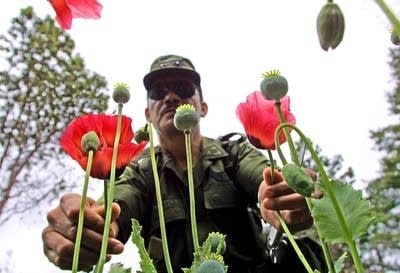Law enforcement's strategy to choke heroin trafficking
Go Deeper.
Create an account or log in to save stories.
Like this?
Thanks for liking this story! We have added it to a list of your favorite stories.

Police in Duluth are waiting for official word whether heroin caused a person's death last weekend. Four others are suspected of overdosing on the drug.
It's the latest in a string of heroin-related incidents law enforcement and public health officials around the state have been dealing with over months.
However, federal officials say they have a strategy that is working to cut down on the amount of heroin coming into Minnesota.
Federal law enforcement officials say the heroin that shows up in Minnesota comes to the state across the U.S. border from Mexico. For the most part, it is heroin from the Sinaloa drug cartel that is trafficked to Chicago and then to points around the Midwest.
Turn Up Your Support
MPR News helps you turn down the noise and build shared understanding. Turn up your support for this public resource and keep trusted journalism accessible to all.
Officials say drug cartels have formed relationships with established street gangs that distribute and sell the heroin. And it's that relationship law enforcement agencies are trying to exploit.
Heroin In Minnesota
• How drug cartels become multi-billion-dollar businesses
• Heroin addicts hooked via prescription opiates
• A new 'epidemic' of heroin use
• Minnesota has high-purity, low-cost heroin
• Duluth major asks to action
It's called the "choke point" strategy by Jack Riley, the special agent in charge for the Drug Enforcement Administration's Chicago Field Division.
"The choke point was where the two entities, criminal groups, had to meet," Riley said.
It's the place where deals between crime organizations are completed; where Mexican cartels meet up with street gangs to swap money and drugs.
For years, Riley says the DEA focused more on infiltrating the cartels, while local police enforced street-level drug trade.
"But nobody was focusing in that middle area where they're extremely vulnerable," Riley said. "You know you've got cultural differences, language differences. You're exchanging money and drugs and guns and a lot of things happen."
"We're hurting the organizations where once we only hurt bits and pieces. We're now going at the heart of it."
Riley said shifting resources to the "choke point" gives DEA agents yet another place to infiltrate. The idea, he said, is to take out the whole organization — the cartel and the gangs distributing the drugs.
The data in Minnesota show a rising number of overdoses and deaths linked to heroin and other opiates. According to a report released in June, a record 120 people died from heroin and other opiates in the Twin Cities last year.
Riley said the strategy is working. In the last six months in Chicago — the epicenter of the region's heroin problem, Riley said — has shown improvement. He said the price of heroin has shot up in some areas where enforcement measures have successfully curbed the supply. And, higher-level drug traffickers are going to prison, he said.
Riley is hopeful that what's happening in Chicago translates into fewer heroin deaths and overdoses throughout the region.
"We're hurting the organizations where once we only hurt bits and pieces. We're now going at the heart of it," Riley said. "I think that will affect the availability of drugs to, for instance, a street gang group that may be operating in Minnesota."
Locally, law enforcement officials say it's hard to know what's working.
"How do you prove what isn't happening?" asked Wade Setter, superintendent of the Minnesota Bureau of Criminal Apprehension.
He said agencies are sharing more information, there have been more arrests for heroin and more heroin seized around the state.
As far as the "choke point" strategy goes, Setter is not critical of it, but said it can be expensive.
"There's some specialized law enforcement techniques that are very labor intensive," Setter said. "As budgets have dwindled that's been a challenge for us to try and focus our existing resources at the best possible point for the biggest return in that investment."
While law enforcement officials focus on cutting the supply of drugs, some in the public health community say reducing overall demand needs to be greatly emphasized.
Whenever there is an effort to take on a specific drug, the abuse pops up elsewhere, said Jay Jaffee, the alcohol and drug abuse prevention coordinator at the Minnesota Department of Health.
"We saw that in the '90s with crack cocaine. We squeezed on that and we saw methamphetamine increase. We squeezed on that and we saw prescription drug abuse increase," Jaffee said. "It's always something."
The people in law enforcement Jaffee deals with seem to agree that there needs to be a balanced approach, that you can't arrest your way out of a drug problem, he said.




